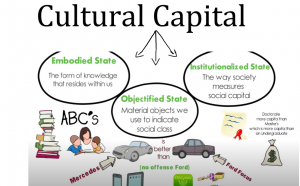For this assignment, students are to pick a term to define in three forms (parenthetical, sentence and expanded definitions), using at least four expansion strategies, one of which is visual. The goal of this assignment, with reference to assigned textbook pages, is to inform an audience of “non-technical readers” about your chosen term. Students must use outside sources in their responses.
The term used: Cultural Capital
Audience: You are a Human Resource professional assigned to lead an inclusivity training program in a private company. You will discuss the meaning of cultural capital and how it informs an individual’s life outcomes. The goal is to create a safe space for professionals to speak openly about their lived experiences and create a greater understanding among colleagues with a comprehensive understanding of the term.
Parenthetical Definition:
- An individual’s cultural capital (non-financial social assets such as education, intellect, style of speech, etc.) promotes social mobility, power and success beyond their economic means.
Sentence Definition:
- Cultural capital is a collection of symbolic elements, such as skills, tastes, posture, clothing, mannerisms, material belongings, credentials, etc., that one consciously or unconsciously acquires either through their family or their environment, which gives them an advantage in social life.
Expanded Definition:
History:
- In the 1970s Pierre Bourdieu, a French sociologist, developed the idea of cultural capital to conceptually explain the differences among the levels of performance and academic achievement of children within the educational system of France in the 1960s, noting that economic obstacles are not sufficient to explain the disparities among them (Robbins, 2005; Roose et al., 2020). In his work, he asserted that variables such as race, gender, nationality, and religion often determine who has access to different forms of knowledge. This knowledge, norms and values can then be used to get ahead and rise up the social hierarchy.
Analysis of Parts:
- One must break down its three primary dimensions to get a comprehensive image of cultural capital and its role in informing and shaping one’s lived experiences. There are three main cultural capital types: objectified state, institutions, and embodied capital.Firstly, an institution’s formal recognition of a person’s cultural capital, typically academic credentials or professional qualifications, is known as an institutionalized state(O’ Shea, 1987). The labour market is where institutionalized cultural capital has the biggest societal function since it allows an individual to show their range of cultural capital through qualitative and quantitative measurements (which are compared against the measures of the cultural capital of other people). As such, recent immigrants, for example, may face barriers to gaining meaningful employment due to the lack of recognition of their international work experience/credentials in the Canadian workplace(Oreopoulos, 2011). Secondly, the embodied state is a personal form of intergenerational network and relationship transfer (Pollard & Alexander,2019). Families, for example, provide a network of lifestyle habits and relationships that serve as a sort of “advancement” to the next generation of children. These family ties tend to shape people’s behaviour and values from generation to generation, including manners, connections, qualifications, and habits of life and livelihood.Finally, the objectified state refers to objects with monetary or symbolic meaning, such as luxury cars, designer clothing labels, fine jewelry, and vintage items (Snežana, 2017). They can also signal status, wealth, and experience, as well as affiliation with a particular culture or community.
Visual:
Figure 1 illustrates how cultural capital is divided into three dimensions with simple definitions and examples contextualizing the different states.
TEDx Talks. “Cultural Capital | Natasha Warikoo | TEDxColumbiaCollegeChicago.” YouTube, 4 June 2018, https://www.youtube.com/watch?v=5DBEYiBkgp8.
Compare and Contrast:
- Oftentimes people use the terms social capital and cultural interchangeably, however, they have completely different meanings. Social capital refers to social connections (e.g., made through employment or clubs) (Oreopoulos, 2011). Cultural capital, on the other hand, is broader and refers to knowledge and academic credentials (institutionalized cultural capital), cultural possessions such as art (objectified cultural capital), and ways of speaking or manner, for example, demonstrated through posture or gestures (embodied cultural capital).
References:
Oreopoulos, P. (2011). Why do skilled immigrants struggle in the labor market? A field experiment with thirteen thousand resumes. American Economic Journal. Economic Policy, 3(4), 148-171. https://doi.org/10.1257/pol.3.4.148
O’ Shea, D. W. (1987).”handbook of theory and research for the sociology of education” (book review). American Sociological Association.
Pollard, D., & Alexander, P. (2019). ‘an attempt to tip the scales’: Music and embodied capital in an english secondary school. British Journal of Sociology of Education, 40(3), 309-323. https://doi.org/10.1080/01425692.2018.1540293
Robbins, D. (2005). The origins, early development and status of bourdieu’s concept of cultural capital. The British Journal of Sociology, 56(1), 13-30. https://doi.org/10.1111/j.1468-4446.2005.00044.x
Roose, H., Atkinson, P., Delamont, S., Cernat, A., Sakshaug, J. W., Williams, R. A., & Sage Research Methods Foundations. (2020). Cultural capital. SAGE Publications Ltd.
Snežana, Š. (2017). Cultural capital and knowledge: Problems of operationalization in the researches of educational inequalities. Sociološki Preglad, 51(2), 300-323. https://doi.org/10.5937/socpreg1702300S
YouTube. (2015). Cultural Capital. Sociology Live! Retrieved February 8, 2023, from https://www.youtube.com/watch?v=5DBEYiBkgp8.

Leave a Reply